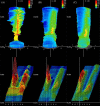Three-dimensional imaging of upper esophageal sphincter resting pressure
- PMID: 31890883
- PMCID: PMC6929582
- DOI: 10.1002/lio2.324
Three-dimensional imaging of upper esophageal sphincter resting pressure
Abstract
Objective: High-resolution manometry (HRM) is used to analyze upper esophageal sphincter (UES) physiology. Conventional HRM can yield imprecise measurements of UES resting pressure given its unidirectional sensors and averaging of circumferential pressure. In contrast, three-dimensional (3D) measurements can yield precise UES resting pressure data over the entire length of the UES. This study conducted a detailed analysis of UES resting pressure as evaluated by 3D-HRM.
Methods: Seventeen young, healthy adult participants (7 females and 10 males) were recruited. The 3D-HRM system used includes a pressure sensor catheter (outer diameter, 4 mm) and eight-channel transducers arranged circumferentially to acquire pressure data at 45° intervals. The catheter was inserted transnasally into the esophagus and automatically retracted at a speed of 1 mm/s. Participants performed the following tasks: maintain resting breathing, perform breath holding, and perform the Valsalva maneuver. Data were obtained and compared per millimeter over the longitudinal UES length.
Results: Clear 3D waveforms were identified, with greater mean UES pressures in anterior-posterior directions than in lateral directions (P < .05). The anterior distribution was located superior to the posterior portion. Significant differences were observed in mean UES pressures and UES resting integrals between resting breathing and the Valsalva maneuver (P < 0.05). No differences in functional UES length were observed.
Conclusions: The normal UES resting pressure was not directionally uniform in the luminal structure. 3D-HRM imaging of UES resting pressure can help deepen our understanding of UES physiology.
Level of evidence: 4.
Keywords: high‐resolution manometry; pharynx; resting pressure; swallowing pressure; upper esophageal sphincter.
© 2019 The Authors. Laryngoscope Investigative Otolaryngology published by Wiley Periodicals, Inc. on behalf of The Triological Society.
Conflict of interest statement
The authors declare no potential conflicts of interest with respect to this study, authorship, and/or publication of this article.
Figures







References
-
- Sivarao DV, Goyal RK. Functional anatomy and physiology of the upper esophageal sphincter. Am J Med. 2000;108(Suppl 4a):27S‐37S. - PubMed
-
- Palmer JB, Tanaka E, Ensrud E, et al. Motion of the posterior pharyngeal wall in human swallowing: a quantitative videofluorographic study. Arch Phys Med Rehabil. 2000;81:1520‐1526. - PubMed
-
- Clouse RE, Staiano A. Topography of the esophageal peristaltic pressure wave. Am J Physiol. 1991;261(4 Pt 1):G677‐G684. - PubMed
-
- Takasaki K, Umeki H, Enatsu K, et al. Investigation of pharyngeal swallowing function using high‐resolution manometry. Laryngoscope. 2008;118:1729‐1732. - PubMed
LinkOut - more resources
Full Text Sources
Research Materials
